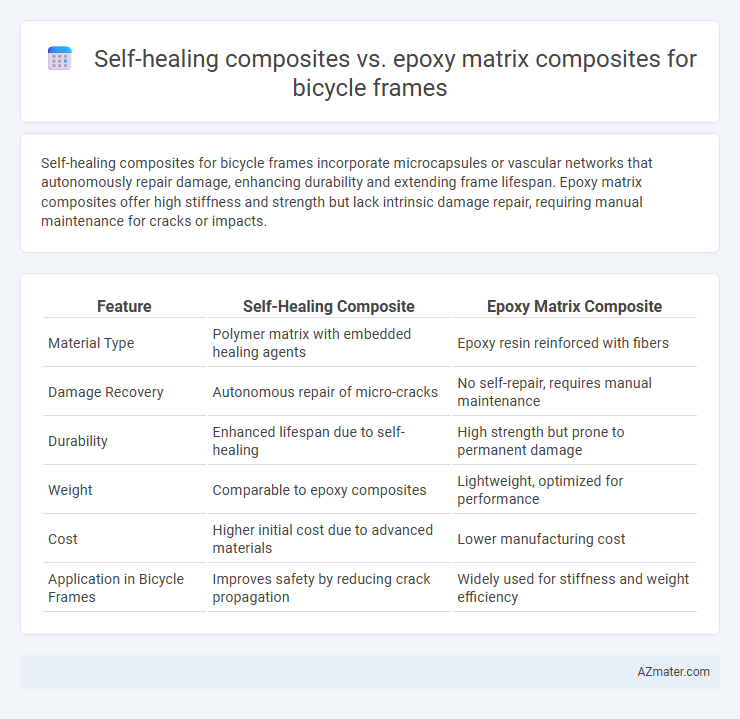Self-healing composites for bicycle frames incorporate microcapsules or vascular networks that autonomously repair damage, enhancing durability and extending frame lifespan. Epoxy matrix composites offer high stiffness and strength but lack intrinsic damage repair, requiring manual maintenance for cracks or impacts.
Table of Comparison
| Feature | Self-Healing Composite | Epoxy Matrix Composite |
|---|---|---|
| Material Type | Polymer matrix with embedded healing agents | Epoxy resin reinforced with fibers |
| Damage Recovery | Autonomous repair of micro-cracks | No self-repair, requires manual maintenance |
| Durability | Enhanced lifespan due to self-healing | High strength but prone to permanent damage |
| Weight | Comparable to epoxy composites | Lightweight, optimized for performance |
| Cost | Higher initial cost due to advanced materials | Lower manufacturing cost |
| Application in Bicycle Frames | Improves safety by reducing crack propagation | Widely used for stiffness and weight efficiency |
Introduction to Bicycle Frame Materials
Bicycle frame materials significantly influence ride quality, durability, and weight, with traditional epoxy matrix composites widely used for their high strength-to-weight ratio and stiffness. Self-healing composites integrate microcapsules or vascular networks capable of autonomously repairing micro-cracks, enhancing frame longevity and safety by preventing crack propagation. Advances in polymer chemistry and nanotechnology enable self-healing composites to maintain mechanical performance while reducing maintenance costs compared to conventional epoxy matrix composites.
Understanding Self-Healing Composites
Self-healing composites for bicycle frames integrate microcapsules or vascular networks containing healing agents within the matrix, enabling automatic repair of micro-cracks, thereby enhancing durability and extending frame lifespan. In contrast, traditional epoxy matrix composites lack this intrinsic repair capability, making them more susceptible to catastrophic failure upon damage accumulation. The self-healing mechanism significantly reduces maintenance needs and improves safety by restoring mechanical integrity without external intervention.
Epoxy Matrix Composites Explained
Epoxy matrix composites are widely used in bicycle frames due to their exceptional strength-to-weight ratio, excellent adhesion properties, and resistance to environmental degradation. These composites consist of a polymer matrix (epoxy resin) reinforced with fibers such as carbon or glass, providing superior stiffness and impact resistance compared to traditional materials. While self-healing composites aim to improve durability by autonomously repairing damage, epoxy matrix composites remain the industry standard for high-performance bicycle frames because of their proven reliability and structural integrity.
Mechanical Performance Comparison
Self-healing composites for bicycle frames exhibit enhanced durability by autonomously repairing micro-cracks, significantly extending fatigue life compared to traditional epoxy matrix composites. While epoxy matrix composites offer high initial tensile strength and stiffness, they lack intrinsic damage repair mechanisms, resulting in progressive structural degradation under repetitive stress. Mechanical performance analysis shows that self-healing composites maintain mechanical integrity over prolonged cyclic loading, reducing maintenance frequency and improving long-term safety in bicycle frames.
Weight and Durability Analysis
Self-healing composites for bicycle frames offer enhanced durability by autonomously repairing micro-cracks, potentially extending the lifespan compared to traditional epoxy matrix composites. While epoxy composites provide a strong, lightweight structure with high stiffness-to-weight ratios, self-healing materials may introduce a slight weight increase due to embedded healing agents or microcapsules. The trade-off between weight and durability favors self-healing composites in applications prioritizing longevity and damage resistance, whereas epoxy matrix composites remain optimal for minimizing frame weight and maximizing stiffness.
Impact Resistance and Damage Recovery
Self-healing composites for bicycle frames offer superior impact resistance through embedded microcapsules or vascular networks that autonomously repair microcracks, significantly reducing damage propagation compared to conventional epoxy matrix composites. Epoxy matrix composites, while providing high initial strength and stiffness, lack intrinsic damage recovery capabilities, leading to permanent structural weakness after impact events. The integration of self-healing mechanisms enhances durability and extends the service life of bicycle frames by restoring mechanical integrity following impact-induced damage.
Manufacturing Process Differences
Self-healing composites for bicycle frames incorporate microcapsules or vascular networks embedded within the matrix, enabling autonomous crack repair during service, while epoxy matrix composites rely on traditional curing and hardening without damage recovery features. Manufacturing self-healing composites demands precise embedding of healing agents during layup, often increasing complexity and cost compared to the straightforward layering and curing of epoxy matrix composites. The self-healing process typically involves additional steps such as catalyst integration and controlled curing environments to ensure effective healing activation, contrasting with the simpler thermal or UV curing processes used for epoxy matrix composites.
Cost Implications and Sustainability
Self-healing composites for bicycle frames typically involve higher initial manufacturing costs due to advanced materials and specialized processing techniques compared to conventional epoxy matrix composites, which are widely produced and economically efficient. From a sustainability perspective, self-healing composites reduce lifecycle environmental impact by extending frame durability and minimizing repair-related waste, whereas traditional epoxy composites often lead to more frequent replacements and increased carbon footprint. Cost savings over time through reduced maintenance and improved longevity make self-healing composites a promising investment despite their higher upfront price.
Real-World Applications in Bicycles
Self-healing composites enhance bicycle frame durability by autonomously repairing micro-cracks, significantly extending frame lifespan and reducing maintenance frequency in real-world cycling conditions. Epoxy matrix composites offer high strength-to-weight ratios and stiffness, making them the standard choice for competitive racing bikes demanding performance and rigidity. Integration of self-healing materials in bike frames is increasingly recognized for its potential to improve safety and reliability in everyday and off-road cycling environments.
Future Trends and Innovations
Self-healing composites for bicycle frames incorporate microcapsules or vascular networks that autonomously repair cracks, enhancing durability and extending frame lifespan compared to traditional epoxy matrix composites. Emerging innovations focus on integrating advanced nanomaterials, such as graphene and carbon nanotubes, to improve mechanical strength and self-repair efficiency while reducing weight. Future trends emphasize sustainable, smart composites with embedded sensors for real-time damage detection and adaptive responses, revolutionizing bicycle frame performance and maintenance.

Infographic: Self-healing composite vs Epoxy matrix composite for Bicycle frame
 azmater.com
azmater.com